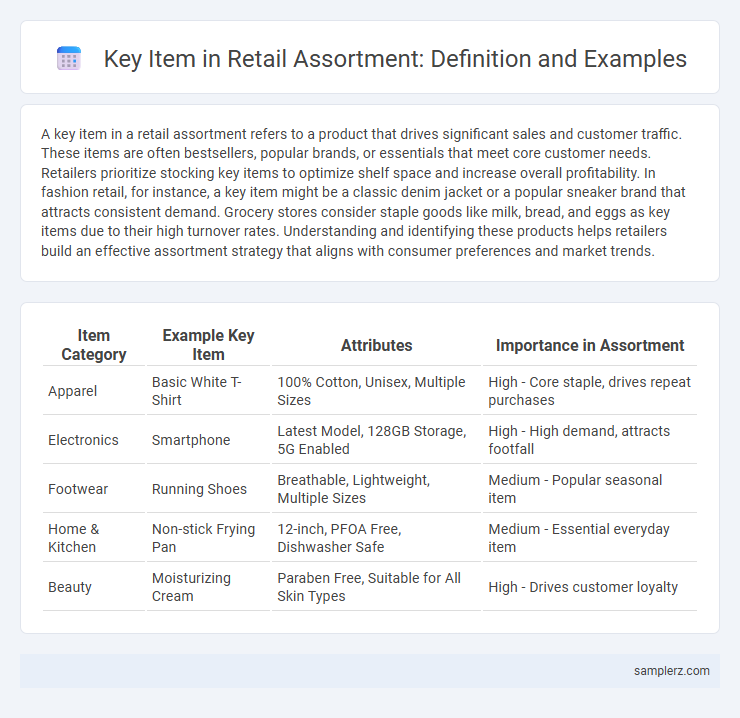A key item in a retail assortment refers to a product that drives significant sales and customer traffic. These items are often bestsellers, popular brands, or essentials that meet core customer needs. Retailers prioritize stocking key items to optimize shelf space and increase overall profitability. In fashion retail, for instance, a key item might be a classic denim jacket or a popular sneaker brand that attracts consistent demand. Grocery stores consider staple goods like milk, bread, and eggs as key items due to their high turnover rates. Understanding and identifying these products helps retailers build an effective assortment strategy that aligns with consumer preferences and market trends.
Table of Comparison
| Item Category | Example Key Item | Attributes | Importance in Assortment |
|---|---|---|---|
| Apparel | Basic White T-Shirt | 100% Cotton, Unisex, Multiple Sizes | High - Core staple, drives repeat purchases |
| Electronics | Smartphone | Latest Model, 128GB Storage, 5G Enabled | High - High demand, attracts footfall |
| Footwear | Running Shoes | Breathable, Lightweight, Multiple Sizes | Medium - Popular seasonal item |
| Home & Kitchen | Non-stick Frying Pan | 12-inch, PFOA Free, Dishwasher Safe | Medium - Essential everyday item |
| Beauty | Moisturizing Cream | Paraben Free, Suitable for All Skin Types | High - Drives customer loyalty |
Defining Key Items in Retail Assortment
Key items in retail assortment are products that drive the majority of sales and customer traffic, often representing high-demand, essential, or seasonally relevant goods. These items are strategically selected based on sales data, market trends, and customer preferences to optimize inventory turnover and profitability. Prioritizing key items ensures alignment with consumer needs, enhancing overall store performance and competitive advantage.
Importance of Key Items for Retail Success
Key items in retail assortment, such as bestselling electronics or bestselling fashion staples, drive significant revenue and attract consistent customer traffic. These products often establish brand identity and influence purchasing decisions, enabling retailers to optimize inventory turnover and maximize profit margins. Successful retailers strategically focus on key items to enhance customer satisfaction and secure competitive market positioning.
Criteria for Selecting Key Items
Key items in retail assortment selection must exhibit high sales volume, strong customer demand, and significant profit margins to drive overall store performance. These products often demonstrate consistent turnover rates and align closely with the brand's market positioning and target demographics. Prioritizing items with supplier reliability and favorable shelf placement enhances both inventory efficiency and shopper satisfaction.
Apparel: Classic Jeans as a Key Item
Classic jeans serve as a foundational key item in apparel assortments due to their enduring popularity and versatile styling options. Retailers prioritize stocking diverse fits, washes, and sizes of classic jeans to meet a wide range of customer preferences and body types. Consistent demand for classic jeans drives steady sales and reinforces brand loyalty in the competitive retail apparel market.
Electronics: Best-Selling Smartphones Example
Best-selling smartphones, such as the Apple iPhone 14 series and Samsung Galaxy S23, serve as key items in electronics retail assortments due to their high demand and strong brand recognition. These flagship devices drive significant foot traffic and revenue, influencing consumer preferences and boosting sales of related accessories. Retailers prioritize stocking these models to capitalize on market trends and maximize profit margins.
Grocery: Everyday Essentials as Key Items
Everyday essentials such as bread, milk, and eggs serve as key items in grocery assortments, driving consistent foot traffic and repeat purchases. These staples anchor the product mix, ensuring steady sales and customer satisfaction. Retailers optimize shelf placement and inventory levels of these items to maximize turnover and enhance overall store performance.
Home Goods: Must-Have Kitchen Appliances
Key items in a home goods assortment often include must-have kitchen appliances such as high-performance blenders, multi-function air fryers, and smart coffee makers. These appliances consistently drive sales due to their versatility, time-saving features, and appeal to health-conscious consumers. Retailers stocking these essentials can boost customer satisfaction and increase average transaction values.
Seasonal Key Items: Holiday Merchandise
Seasonal key items in retail assortment, such as holiday merchandise, drive significant sales during peak periods like Christmas, Halloween, and Easter. These products include themed decorations, gift sets, and specialty foods tailored to festive occasions, boosting store traffic and increasing average transaction values. Retailers strategically stock limited-time seasonal items to create urgency and capitalize on heightened consumer spending patterns around holidays.
Strategies for Highlighting Key Items In-Store
Highlighting key items in-store involves strategic placement such as endcap displays and eye-level shelving to maximize customer visibility and engagement. Utilizing multimedia signage and interactive displays effectively draws attention to promotional products, enhancing the perceived value and urgency. Incorporating cross-merchandising techniques by pairing key items with complementary products can drive higher basket sizes and improve sales conversion rates.
Impact of Key Items on Customer Buying Decisions
Key items in retail assortments significantly influence customer buying decisions by acting as anchor products that drive foot traffic and increase basket size. These products, often top-sellers or exclusive offers, create perceived value and confidence, encouraging customers to explore complementary items. Strategic placement and promotion of key items enhance overall sales performance and foster brand loyalty.

example of key item in assortment Infographic
 samplerz.com
samplerz.com